Ancient CHamoru/Chamorro Use of Human Bones
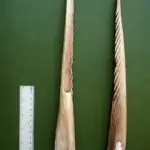
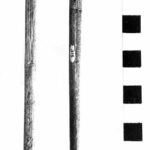
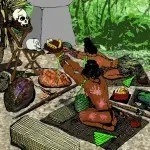
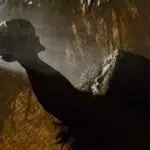
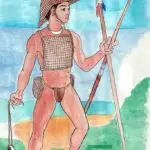
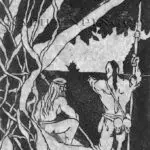
Table of Contents
Share This
Used to make tools and weapons
Archeological studies have revealed that during the Latte Period ancient CHamorus/Chamorros retrieved bones from deceased bodies after tissue had deteriorated, and used the bones for use as tools or weapons.
Father Peter Coomans, a Jesuit missionary in the 1670s, described how leg bones were retrieved:
To make the former, they despoil corpses of their leg bones, and the longer ones are the most desirable ones. For instance, should they want to get their hands on longer leg bones, they bury the corpses of the dead at a suite, so that the earth would hardly cover the legs from the hips down to the heels, to which they tie small cords, so that, when the ligaments have already putrefied, they pull them [i.e., the leg bones] out and intact from the rest of the body.
Presumably, skulls were retrieved in a similar way.
The long bones then could be fashioned into effective weapons by creating a sharp tip, and then adding a double or triple row of barb-like teeth, so that the spear tip would enter the body easily but be difficult to extract, or break off leaving a barb inside the victim’s flesh. Some of the best examples of human bone spear tips have been retrieved from excavations in Saipan. Usually, it was the long bones of enemy corpses that were used to make spear points and other tools, so great care was taken to bury loved ones near their homes in order to prevent rivals from retrieving their skeletal remains.
Ancestor veneration
The removal of skulls from burials, however, served a more spiritual purpose for the CHamorus. One of the earliest written historical accounts of CHamorus is from Catholic missionary Fray Juan Pobre de Zamora, who, in 1602, jumped ship off the shores of Rota, an island north of Guam, and lived there for several months. He wrote that CHamorus held the skulls of their ancestors, especially of parents and grandparents, in high regard.
These skulls were “kept in a high place inside their houses and, toward them, they make a kind of bowing gesture, thereby showing them a degree of respect.” Fray Pobre further described how the skulls were used as tokens of good luck, especially for fishing. Offerings of fresh fish or turtle caught during fishing expeditions would be placed before the oldest skulls in a special ceremony, inviting the dead ancestors to eat with them.
The ancestral skulls were also used by the makahnas―the traditional healers or shamans―for special prayers and ceremonies. According to Spanish accounts, the CHamorus believed that the spirit of the dead ancestor (aniti or plural maknganiti) resided in the skull. The skulls were kept in little baskets in the house of the makahna, who could communicate with the maknganiti and invoke favors from them for fishing or other daily activities, for healing, rainfall, or to seek protection from harm. The makahna also used the skulls to predict the future―a practice the Catholic priests strongly rejected. These practices were linked with the CHamoru belief in the immortality of the soul and the afterlife.
According to Catholic missionary Father Diego Luis de San Vitores, the CHamorus believed that the souls of individuals who died a peaceful death would go to a paradise beneath the earth, where there was an abundance of bananas, coconuts, sugar cane and other fruits. Individuals who died violently, on the other hand, ended up in Sasalaguan, a place similar to the Christian notion of hell.
More importantly, the CHamorus believed the souls of individuals could return to earth and visit with relatives. At the time of death, a basket would be placed near the individual’s head as an invitation for the deceased to return for a visit. At other times, an individual’s corpse, anointed with fragrant oils, would be taken from house to house of different relatives to offer the aniti a place to remain among the living. Thus, the skull retrieved from a burial represented the tangible presence of the ancestral spirit, and therefore was given a special place in the home.
For further reading
Cunningham, Lawrence J. Ancient Chamorro Society. Honolulu: Bess Press, 1992.
Driver, Marjorie G. The Account of Fray Juan Pobre’s Residence in the Marianas, 1602. MARC Miscellaneous Series No. 8. Mangilao: Micronesian Area Research Center, University of Guam, 1993.
Freycinet, Louis Claude Desaulses de. An Account of the Corvette L’Uraine’s Sojourn at the Mariana Islands, 1819. Translated by Glynn Barratt. Saipan: Commonwealth of the Northern Mariana Islands Division of Historic Preservation, 2003.
Russell, Scott. Tiempon I Manmofo’na: Ancient Chamorro Culture and History of the Northern Mariana Islands. Saipan: Commonwealth of the Northern Mariana Islands Division of Historic Preservation, 1998.
